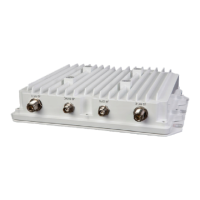3-18
RF-7800W
SYSTEM ADMINISTRATION AND CONFIGURATION
3.8.10.4 EIM Auto Channel Change
When interference is detected, the radio has the option of initiating all radios to jump to a new, potentially cleaner
operating frequency. There is minimal downtime when this occurs successfully, but sometimes the radios may jump
to another interference situation. The radios will iterate through a number of frequencies. If interference is found on
many different frequencies, one likely conclusion is that the radio is being deliberately interfered with over its entire
operating band. This situation is known as “barrage interference” and results in the radios settling on the last
operating frequency. When the radios change channels and if barrage interference is detected, different SNMP traps
are sent to network managers. EIM may be purchased separately. Refer to Paragraph 5.6.
3.8.10.5 EIM Relative Noise Floor
While EIM is turned on, the radios monitor the noise floor of the channel during the quiet periods between
transmissions. The difference between the expected noise and the measured noise is displayed as the relative noise
floor. This value will vary with different installation environments. A sharp increase in this value relative to the
average value could indicate the presence of interference. EIM may be purchased separately. Refer to Paragraph 5.6.
3.8.11 Statistics
The radio provides the number of transmitted and received data packets, along with how many packets were
retransmitted or discarded due to errors.

